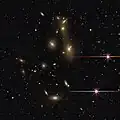| NGC 5177 | |
|---|---|
 NGC 5177 with SN 2010cr May 19, 2010 | |
| Observation data (J2000 epoch) | |
| Constellation | Virgo |
| Right ascension | 13h 29m 24.2s[1] |
| Declination | +11° 47′ 49″[1] |
| Redshift | 0.021570[1] |
| Heliocentric radial velocity | 6467 ± 29 km/s[1] |
| Distance | 297 Mly (Light Travel-Time)[1] (redshift-based) |
| Apparent magnitude (V) | 15.1g[1] |
| Characteristics | |
| Type | S0[1] |
| Apparent size (V) | 0.81' x 0.46'[1] |
| Other designations | |
| MCG +02-34-019, PGC 47337[2] | |
NGC 5177 is a lenticular galaxy. Based on a redshift of 6467 km/s the galaxy is crudely estimated to be about 300 million light-years away.[1]
On April 16, 2010 UT, the Palomar Transient Factory automated wide-field survey detected a supernova on the outskirts of NGC 5177.[3] The supernova is known as SN 2010cr[4] and is located at 13:29:25.11 +11:47:46.4.[3] A confirmation spectrum was taken with the Palomar Hale telescope on April 17 UT which showed it to be approximately 13 days before peak brightness.[3] The Hubble Space Telescope took STIS/UV spectroscopic observations on May 3, 2010.[5]
Gallery
 The NGC 5171 Group (legacy surveys), containing NGC 5171, NGC 5176, NGC 5177, NGC 5178 and NGC 5179
The NGC 5171 Group (legacy surveys), containing NGC 5171, NGC 5176, NGC 5177, NGC 5178 and NGC 5179 NGC 5177 with SDSS
NGC 5177 with SDSS
See also
References
- 1 2 3 4 5 6 7 8 9 "NASA/IPAC Extragalactic Database". Results for NGC 5177. Retrieved 2010-05-19.
- ↑ "NGC 5177". SIMBAD. Centre de données astronomiques de Strasbourg. Retrieved 2021-02-19.
- 1 2 3 "Nearby supernova, PTF10fps". The Astronomer's Telegram. 2010-04-22. Retrieved 2010-05-19.
- ↑ "List of Supernovae". Central Bureau for Astronomical Telegrams. Retrieved 2011-07-03.
- ↑ Richard S. Ellis (2010-05-03). "HST Preview for OBD708010". [Hubble Legacy Archive]. Retrieved 2010-05-19.
External links
Wikimedia Commons has media related to NGC 5177.
- NGC 5177 on WikiSky: DSS2, SDSS, GALEX, IRAS, Hydrogen α, X-Ray, Astrophoto, Sky Map, Articles and images
This article is issued from Wikipedia. The text is licensed under Creative Commons - Attribution - Sharealike. Additional terms may apply for the media files.